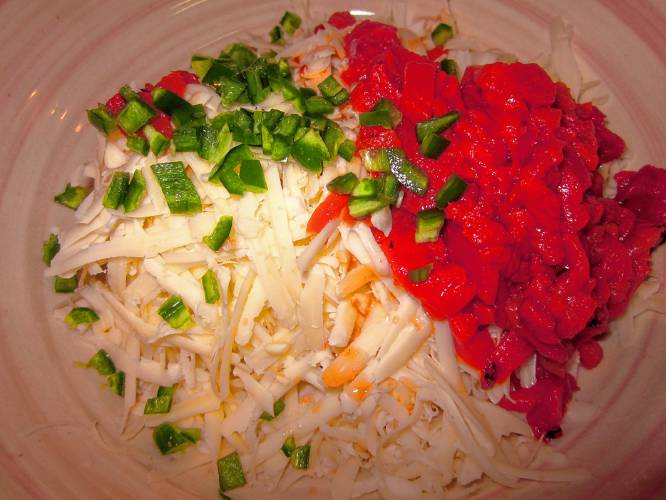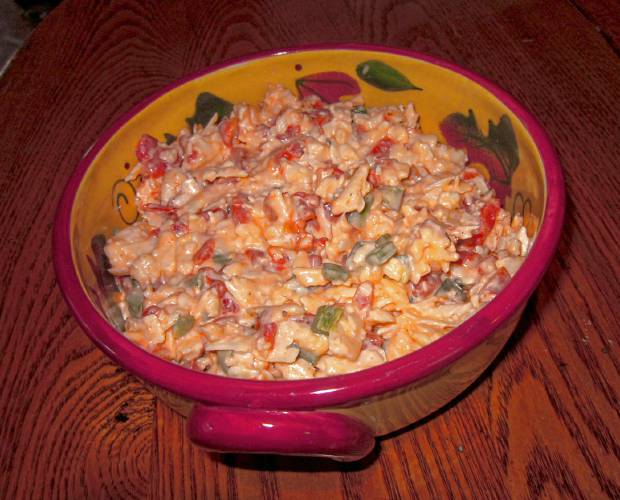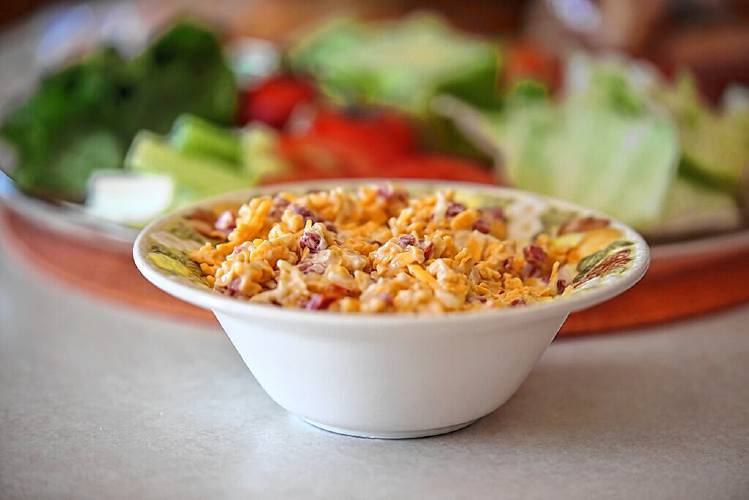The origin story of pimiento cheese: A Southern staple for decades, the colorful cheese spread is gaining popularity in New England
| Published: 07-09-2024 1:19 PM |
Cheese has always been my favorite food category. If I had to choose between it and chocolate, I’d choose cheese (and I adore chocolate). Nevertheless, I was unfamiliar with pimiento cheese for much of my life.
When I was in my early 20s I moved to Tennessee to go to graduate school, and suddenly I encountered this savory spread. It was everywhere. People prepared it at home, and it was available premade in just about every grocery store.
I soon decided I was born to love this food. It’s creamy. It’s salty. It’s colorful.
Pimiento cheese is slowly beginning to appear in grocery stores here in New England. Still, most of us Yankees don’t eat a lot of it.
To southerners, it is a staple. North Carolina novelist Reynolds Price (1933-2011) called it “the peanut butter of [his] childhood — homemade by Mother.” It is also referred to as Carolina caviar or Southern paté.
Interestingly, although pimiento cheese is associated with the South, where many people omit the Spanish-inspired second “i” and call it “pimento cheese,” it originated in New York in the early 1900s.
According to an article by Robert Moss in “Serious Eats,” pimiento cheese originated as “a product of industrial food manufacturing and mass marketing.”
He argues that the cheese represented the marriage of two recently developed industrial products, cream cheese and canned Spanish pimientos (red peppers). That union was officiated by practitioners of the new science of home economics, who loved processed foods.
Article continues after...
Yesterday's Most Read Articles
Spreads that combined the two were marketed throughout the United States, not just in the South. Pimiento cheese became even more popular when farmers in Georgia began growing and canning their own pimientos, bypassing the more expensive and scarcer Spanish peppers.
“After World War II,” writes Moss, “the popularity of pimento cheese began to wane….
“But somewhere along the line, Southern cooks took what originated as an industrial food product and started creating their own recipes for making it from scratch, in the process turning it into something truly delicious that is associated very closely with the South.”
There are many versions of pimiento cheese. My friend Lark Fleury, who lives in Alabama, puts finely chopped or grated onion in hers. Some people, including Stacey Little of the popular food blog “Southern Bite,” hew to the spread’s origins by including softened cream cheese in the mixture.
Pretty much all of the recipes include mayonnaise. Most Southerners will tell you that their mayo of choice is Duke’s.
Indeed, founder Eugenia Duke of South Carolina started selling her mayonnaise commercially only after her pimiento-cheese, egg-salad, and chicken-salad sandwiches became popular at Army canteens during World War I.
She was told that the secret to the sandwiches’ success was the homemade mayonnaise she used. She decided to manufacture mayonnaise instead of making thousands of sandwiches a day.
With all due deference to Duke, who was a pioneering industrialist and (one gathers) a darn good cook, I use Hellmann’s, the mayonnaise of my youth. I don’t mess with the onion, which tends to overwhelm the other flavors in the spread after a few hours.
I vary my spread from time to time. Sometimes I just combine all the ingredients in a bowl. Sometimes I pulverize the cheese mixture completely to achieve uniform consistency and color. It depends on my mood.
My other variation is in the spice. There is always spice for me. (If you don’t like spicy food, feel free to omit it.) Sometimes I put a little chopped fresh jalapeño pepper in my spread. (Pickled peppers may also be used instead of the fresh ones. They respect the origins of the dish in commercial kitchens.)
Sometimes I opt for some canned chipotle in adobo. I adore chipotles, which are basically smoked jalapeños. The smoke adds flavor, but (unless you overdo your chipotles) doesn’t dominate.
Pimiento cheese makes a lovely, easy appetizer. Or a tasty sandwich. Southerners have found myriad ways to use it: for stuffing deviled eggs, in macaroni and cheese, for a cheeseburger with oomph, and so on. Feel free to experiment.
One note: Although it is just fine to use pre-chopped canned pimientos, it is best to avoid purchasing pre-shredded cheddar cheese. That product includes ingredients to keep the cheese from clumping, which you neither want not need.
Just use a box grater to shred the cheese yourself. It doesn’t take long.
Ingredients:
4 ounces roasted red peppers, drained (reserve 1 tablespoon of the liquid) and finely chopped (If you really loved roasted red peppers, use more, up to twice as much!)
1 to 2 chipotles in adobo, seeded if you like them mild, chopped; OR 1 to 2 jalapeño peppers, again seeded if you like them mild, chopped several turns of the pepper grinder
1 tablespoon red-pepper brine
1 to 2 teaspoons adobo sauce from the chipotle can (if you’re using the chipotles)
1/2 pound sharp cheddar cheese, coarsely grated (use really good cheddar; this makes a difference)
mayonnaise to taste (start with 1 tablespoon)
Instructions:
If you want a uniform spread, place the pimientos, the chipotles or jalapeños, the pepper, the brine, and the adobo sauce (if using) in a mini-processor. Whir until combined. Toss in the cheese, and combine again. Add mayonnaise to taste. (You won’t need a lot; try not to use more than 1/4 cup.)
If you want a little more texture, just combine all the ingredients except the mayonnaise in a bowl. Add a little mayonnaise at a time until you have a pleasing spread.
Chill the cheese blend for at least 1/2 hour. Serve with crackers or vegetables, or use your pimiento cheese as a sandwich spread. (It makes lovely tea sandwiches.)
Makes a little more than 1 cup pimiento cheese.
Tinky Weisblat is an award-winning cookbook author and singer known as the Diva of Deliciousness. Visit her website, TinkyCooks.com.










 Putting the students front and center: What can education can look like without high stakes testing?
Putting the students front and center: What can education can look like without high stakes testing? Sounds Local: He’ll play anything you want: Stephen Kellogg will perform an all-request show at Shea Theater, Dec. 19
Sounds Local: He’ll play anything you want: Stephen Kellogg will perform an all-request show at Shea Theater, Dec. 19 Speaking of Nature: Introducing the Birch Perch II: Making improvements to my bird observation venue
Speaking of Nature: Introducing the Birch Perch II: Making improvements to my bird observation venue Conversations over candy-making: Sharing beloved holiday food traditions
Conversations over candy-making: Sharing beloved holiday food traditions
